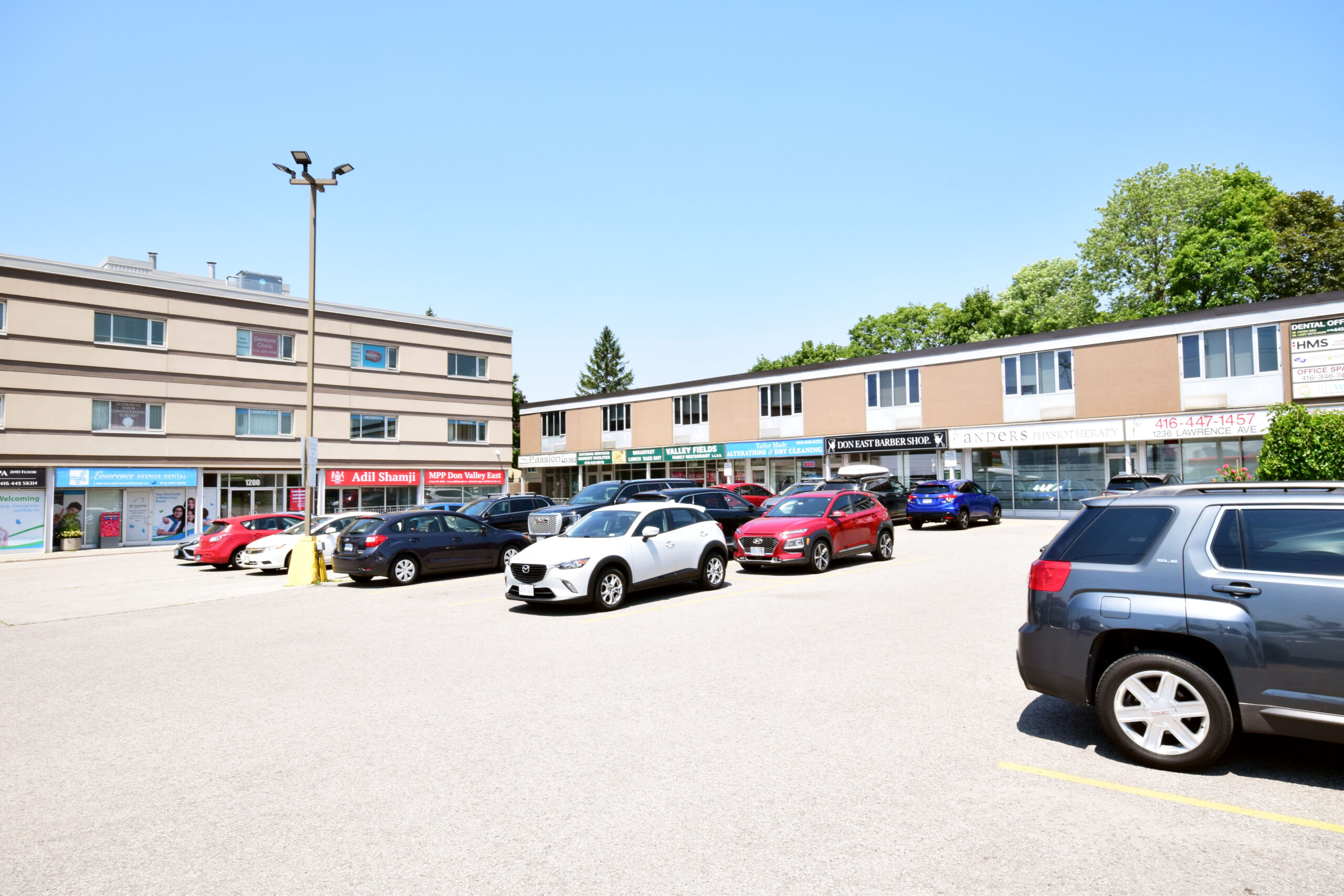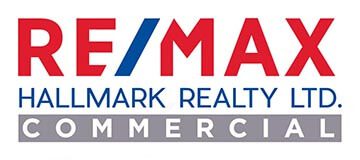CBRE and Colliers are two of the most prominent real estate services and investment firms in Canada, and their leaders answered questions about the industry during a May 20 webinar presented by NAIOP’s Vancouver chapter.
CBRE’s Canadian president and chief executive officer Werner Dietl was joined by Colliers Canada president and CEO Brian Rosen for a conversation with Jenn Podmore Russell, senior vice-president of operations for Vancouver real estate services firm Rennie.
Podmore Russell opened the event by listing several reasons to be optimistic about the economy and the real estate market, including:
– a low-interest-rate environment and the Bank of Canada’s commitment to maintaining it;
– almost $90 billion in savings sitting in the bank accounts of Canadians;
– the strong stock market performance;
– more Canadians being employed now than before the pandemic;
– and an anticipated increase in immigration.
Podmore Russell asked Rosen and Dietl what has them excited at the moment.
Rosen expects the industrial real estate asset class to keep chugging along well and he’s looking forward to an accelerated transformation of retail.
“We haven’t seen that acceleration happen yet, in part because of the hesitance to sell and take some of the write-downs over the last couple of years,” Rosen said. “But, as things start to transform naturally coming out of the pandemic, we’re going to see which service industries and people made it or didn’t make it through, and that’s going to accelerate even further some of the transformation.”
Rosen said building supply chain facilities in areas that have higher rent profiles isn’t currently profitable for businesses or building owners, so it will take bold visions and a lot of reimagining to make last-mile delivery work more efficiently.
Dietl believes industrial and multifamily will remain strong asset classes and retail will be a big part of an increase in mixed-use developments.
The future of office spaces
Dietl thinks offices still have a bright future but will be used in different ways. Flexible and agile workspaces will be important within portfolios.
Dietl said more end-users may start owning their spaces instead of leasing them so they have more control over their environment and can make employees feel more comfortable: “What does the future look like for the best and the brightest and how do they want to operate, and how do you find a way to balance that with what the company wants, to foster collaboration?”
Rosen feels offices are critical for gathering, collaboration and innovation, especially in real estate-related businesses where brokers can use them to get to know clients better.
Many tenants are still unsure about their plans and are deferring major lease decisions and looking for shorter terms, according to Rosen. Some are also experimenting with technology and designing more modular spaces.
Dietl said there are fully built-out office spaces available to sublet in the market which are receiving multiple offers.
“Trading volume hasn’t returned on the leasing side to what it was, but there is activity,” he noted. “Even in the lockdown cities of Montreal and Toronto, the activity that’s going is decent, given the lockdown and COVID playing much better.”
Demand for investment properties
Last year was dominated by private capital, with high-net-worth investors, value-add funds and opportunity funds driving investment activity, according to Dietl. More institutional money is now looking at longer-term opportunities as market conditions have stabilized.
Dietl said data centres, life sciences facilities and self-storage properties have become more mainstream, and he thinks other new asset classes will emerge.
While Rosen said there are well-funded and sophisticated buyers in the marketplace, the slow pace of getting buildings built is constraining supply, which is driving a hunt for product and increasing prices.
Rosen said investment activity and transactions are picking up again in the hospitality sector, with some hotels being converted to multifamily residences. He thinks travel, including business travel, will accelerate more in 2022 than this year.
Dietl has seen strong interest in hospitality properties that have been on the market, but said it’s very value-driven. He also thinks business travel will recover and he expects longer business trips of a few days instead of quick in-and-out visits.
Rosen said Canada is viewed as a very attractive real estate and business investment market – despite its relatively high costs – due to its quality of life and access to great talent. He’s spoken with several American clients who can’t wait for border restrictions to be lifted because they have technology companies eager to set up in Toronto, Montreal and Vancouver.
“There’s a lot more international capital that could be coming in to the marketplace,” said Rosen. “What we struggle with versus the U.S. is we don’t really have secondary cities.”
Dietl agreed and said mass transit infrastructure is needed in secondary markets, but it’s very expensive to create and operate.
“Canada is a great country to invest in and our major cities are coveted. The challenge for many international investors is that our asset base is too small.”
Real estate industry growth challenges
Another growth challenge, according to Dietl, is the amount of bureaucracy and long waiting times involved with the permitting process.
Dietl said more funding is needed for real estate programs in Canadian universities and the industry itself has to do a better job of promoting itself to attract top talent.
“When you think of the total GDP that comes out of our sector, it’s massive. But, we play it down. Maybe it’s a Canadian thing, but we’re just way too humble.”
Rosen added the industry also has to improve in accessing more talent from different races, genders and business backgrounds by demystifying real estate and making it more attractive. Rosen and Dietl agreed on a need to engage with communities on a local grassroots level, and that can be driven from up top.
Real estate is successful when the community around it is successful, so Dietl said efforts have to be made by companies to improve communities through improving access to affordable housing, food and childcare.
“We’re all trying to do our best to make a difference,” concluded Rosen.
Source Real Estate News Exchange. Click here to read a full story
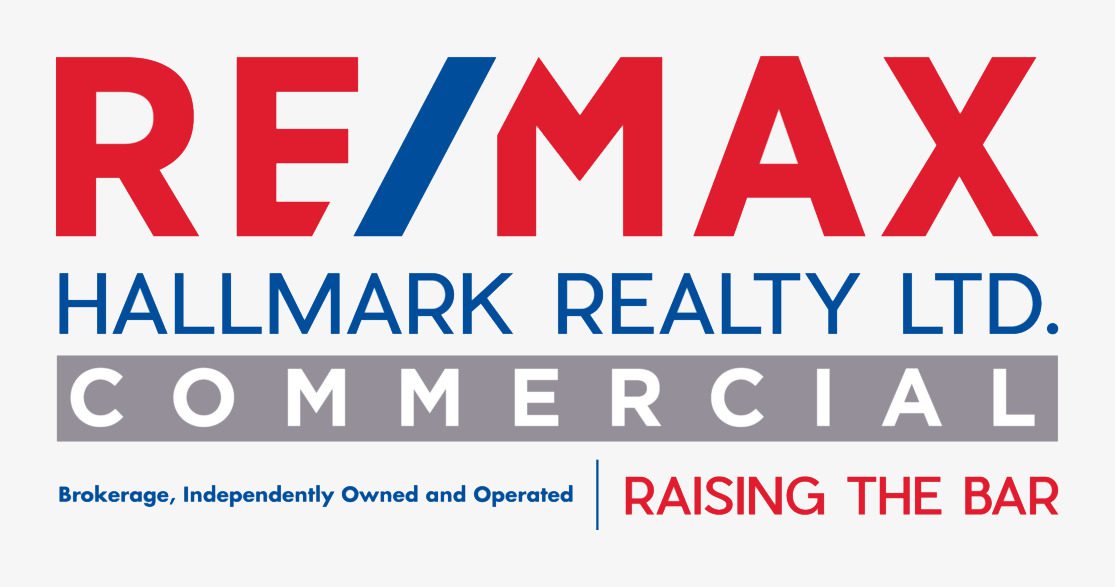
A panel of senior real estate executives shared insights about their companies and the state of the industry to conclude the 17th annual Land & Development Conference, which is based in Toronto but offers a national overview.
Jodi Shpigel, project lead for First Capital’s 2150 Lake Shore, and KingSett Capital group head of development Jeff Thomas moderated the event, which was held virtually for the second consecutive year due to COVID-19 restrictions.
They were joined by: Dream president and chief responsible officer Michael Cooper; Fengate managing director and group head of real estate Jaime McKenna; Fiera Real Estate president and head of global real estate Richard Dansereau; and Trinity Group president and chief executive officer Fred Waks.
The ongoing effects of the pandemic played a role in insights from each of the panelists. However, because of the diversity of asset classes in which their companies are involved, they provided a wide-ranging overview of strategies which have been employed to mitigate its impact, capitalize on opportunities and prepare their firms for the coming recovery period.
Dream
“We made a big commitment into measuring our returns, both financial as well as social, as part of our impact investing strategy,” said Cooper on Dream’s focus during the pandemic.
This includes putting an emphasis on mixed-use affordable market housing, making its real estate and operations more inclusive, and making its buildings less harmful to the environment.
“We’re looking at our leases to see how we can make it easier for women-led businesses and other underserved groups to enter into leases with our organization,” said Cooper.
Dream has been hiring during the pandemic and Cooper said it has the best management team in company history, which has helped provide resiliency and increased its liquidity.
Dream Office sold 140 of its 172 buildings from 2015 to 2019 because Cooper didn’t think those it disposed of would be able to compete in the future. The REIT also ensured the older assets it decided to keep will continue to “have a great life ahead of them,” Cooper added.
Cooper said people have been thinking more about where they live since the onset of the pandemic and he believes they’re probably investing more of their disposable income toward that fundamental need.
Fengate
McKenna spoke about Fengate’s exposure to both student housing and seniors housing, two asset classes dramatically impacted by the pandemic.
“Student housing was the most dramatic because, within five minutes, we went from 100 per cent occupancy to 20 per cent occupancy,” she said.
Fengate’s Seasons Retirement Communities limited the impact of COVID-19 via a strong focus on the management of its staff, according to McKenna.
“Whether it was bonuses or other initiatives, we really focused on retaining staff, making them feel safe and making them feel valued, because if they were there we were going to be able to do the best job for our tenants.”
McKenna said Fengate didn’t let COVID-19 drive or force changes to its portfolio strategy. The firm has, however, spent the past 18 months “trimming around the edges” and shedding assets that don’t fit its long-term goals.
Fengate has also internalized much of its development with the creation of a new team, said McKenna, and is making sure it’s partnered with like-minded developers.
Two-thirds of immigrants rent housing after arriving in Canada and the immigration floodgates are expected to open before the end of the year after being largely closed during the pandemic.
While Toronto and Vancouver apartment occupancies suffered due to the lack of immigration and young people moving back home with their parents, McKenna believes that will turn around in the next six to 12 months.
McKenna said communication has become disjointed since most office workers have been doing their jobs from home. She doesn’t see this as a feasible long-term solution although she’s open to some form of hybrid of the traditional five-days-in-the-office workweek.
Fiera
Dansereau noted industrial properties, rental apartments and life sciences facilities are generating the most interest throughout North America and Europe.
Transactions slowed last year due to the market uncertainty caused by the pandemic. A lack of acquisition opportunities has created pent-up demand and capital, which has been sidelined since March 2020.
“We’ll be looking at a more stable market, but, for the time being, if you’ve got a good quality industrial building in the GTA (Greater Toronto Area), you’ll have a lot of bids,” said Dansereau.
Touching on a theme also raised by McKenna, Dansereau said increased immigration is important to the real estate industry and vital to the economy in general.
“We need more people to help pay for the debt that we’ve accumulated through this pandemic. And if you look at the statistics, the expectation is that, by 2040, people 65 years or older will represent 25 per cent of the population. Today that’s 17 per cent.”
Dansereau said 86 per cent of Fiera employees were anxious to return to the office, but that same percentage was also keen on being able to continue to work remotely a few days a week. He expects offices to more closely resemble pre-pandemic occupancy levels and patterns later in 2022.
Trinity
Waks said Trinity is largely focused on the GTA and Ottawa markets at the moment, but is also having success with its Trinity Hills at Canada Olympic Park mixed-use development in Calgary.
It will have 350,000 square feet of retail, 250,000 square feet of office space and 2.05 million square feet of residential space upon completion, according to Trinity’s website. Phase one includes 160 residential rental units, a 400-unit seniors home and almost 90,000 square feet of retail.
Montreal and Vancouver are also solid markets, according to Waks. While Trinity doesn’t own industrial space, Waks noted the gap between industrial and retail rents is narrowing due to the recent strengths of the former and weaknesses of the latter.
Waks said the rising costs of concrete, steel and lumber have been having a negative impact on development, especially in the GTA.
“It’s almost impossible to sit there and make any sense of a pro forma today at this point in time because the revenue side has not caught up to the cost side.”
Ottawa used to be a more expensive place to build than Toronto, but Waks said that’s no longer the case.
Waks noted many companies, which used to rely primarily on generating rental income and didn’t have their own development teams, are now forming these groups within their organizations.
Trinity has had more staff turnover than he’d like during the pandemic, but has added motivated young employees with expertise in the multiresidential sector.
Waks was the only person physically located in Trinity’s office while he took part in the virtual panel, and he’s looking forward to the return of colleagues to the workplace.
“We’ve managed to buy, we’ve managed to zone, we’ve managed to sell, we’ve managed to develop and we’ve managed to lease — all the things that you’re supposed to be doing at this time. But I don’t think we’re doing it as well as we could.”
Source Real Estate News Exchange. Click here to read a full story
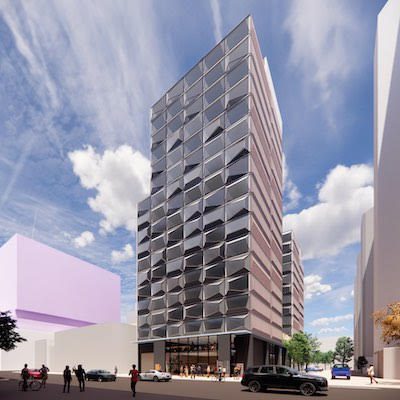
Manga Hotels is in the early stages of its most ambitious growth phase, with one downtown Toronto property under construction and four more hotels planned.
“We have faith in the city and have a long-term view,” company president and chief executive officer Sukhdev Toor told RENX in a recent interview. “It’s a world-class city and we think that after this COVID thing is over that people will travel and there will be pent-up demand because people are tired of sitting at home.”
Manga Hotels has come a long way since it acquired its first property in Victoria in 1988, expanding into more markets and getting into hotel, restaurant and residential development.
The company developed Canada’s first Hampton Inn, a 70-room hotel in Mississauga, in 1999. Nine years later it also built the country’s first LEED-certified hotel, the 224-room Hilton Garden Inn Toronto Airport.
Manga has now built hotels in Mississauga, London, Whitby, Halifax, St. John’s and Buffalo. It also owns and operates hotels in Toronto, Kingston and Fredericton.
Its 19 hotels have approximately 3,700 rooms. Ten are affiliated with Hilton, five are with Marriott and two are with IHG Hotels & Resorts, while there are two independents.
Manga’s downtown Toronto hotel developments
Hyatt Place & Residences Toronto is under construction at 203 Jarvis St. The 32-storey IBI Group-designed tower will combine 239 hotel rooms and 178 apartment units and is scheduled to open in 2023.
That project is further along than the four hotels Manga has planned southwest of that location, in and around what’s known as Toronto’s Fashion District, which have anticipated openings ranging from 2024 to 2026.
Three of them will be part of the new Manga Collection Hotels brand the company is creating.
While municipal approvals are still needed, construction could start as early as late next year on a 240-room hotel at 471 Richmond St. W., and a 131-room hotel at 38 Camden St. The 17- and 15-storey buildings will be designed by Sweeny&Co Architects.
Toor told RENX they’ll be upscale boutique properties offering complimentary food and beverages and should appeal to young professionals.
Municipal approval is also needed for a site at 689 King St. W. that will include two Sweeny&Co Architects-designed buildings.
One will be an 18-storey, 220-room luxury lifestyle hotel and the other will be a 13-storey extended stay hotel with 130 apartment-style rooms with kitchenettes. Toor said construction should start in 2023.
The remaining downtown Toronto property, which won’t be Manga-branded, will be the Hyatt House Downtown Toronto at 184 Spadina Ave., just north of Queen Street West at Cameron Street.
The property is going through the municipal approvals process, but plans are for a 250-room extended stay hotel. Construction could possibly start by late 2022.
The downtown Toronto hotel market
Manga acquired its downtown Toronto sites before the pandemic when the company believed the city’s strong hotel performance of 2018 and 2019 would continue and it would attract large numbers of business travellers and tourists.
“Downtown Toronto is suffering badly,” said Toor. “The airport is obviously bad.
“Some smaller towns are doing OK. But the bigger city centres in Toronto, Vancouver and Montreal have been the hardest hit because they depend more on conferences, meetings and groups, which are non-existent right now.”
Despite the precipitous drop in business over the past 15 months due to COVID-19 travel restrictions, Toor said Manga decided to take a “contrarian view” and stick with its ambitious plans.
It has not sold any of its high-priced real estate, nor has it turned to building apartments or condominiums on its downtown Toronto sites.
“The last year has been very, very tough and it’s still tough and difficult,” said Toor. “The airline, restaurant and hotel industries have been the hardest hit, but we’ve received good support from the federal government to keep us alive.”
Toor is eagerly waiting for the border between Canada and the United States to fully open and for travel to return to pre-pandemic levels.
He’s hopeful the hotel market will be in pretty good shape by September. Toor believes leisure travel will return first, followed by business and conference travel.
Manga’s residential properties
Manga has eight hotels in the Halifax area, including the DoubleTree by Hilton Halifax Dartmouth.
It also owns the land beside that hotel and is in the midst of building three, 30-storey rental apartment buildings on it that should be completed in 2022. The property, at 20 Best St. and overlooking Halifax Harbour, will have more than 700 units.
“Dartmouth and Halifax is a strong market and needs new units, and zoning was available there,” said Toor. “We’re trying to build apartments with hotel-style amenities, lobbies and experiences.”
Manga owns two other residential rental properties.
New Garden Residences is comprised of 37 upscale low-rise units at 209-219 Jarvis St. in Toronto. Star of the Sea Residences is a six-storey apartment building with 85 upscale units at 40 Henry St. in downtown St. John’s.
“Residential has good long-term demand for new units everywhere in Canada,” said Toor.
Manga also plans to build more residential buildings in the Greater Toronto Area, according to Toor.
Source Real Estate News Exchange. Click here to read a full story

Choice Properties Real Estate Investment Trust and The Daniels Corporation plan a fall launch for Mount Pleasant Village, a master-planned community that will include one of the first new purpose-built rental apartment buildings in Brampton in the past 15 years.
“Daniels has an outstanding and recognizable city-building reputation and is so respected,” Choice vice-president of development, design and engineering Amy Chan told RENX. “They’re very much a soup-to-nuts type of developer and we love that they’re such an expert in from-start-to-finish development.”
Choice owned the greenfield site on Bovaird Drive, just east of Creditview Road and adjacent to the Mount Pleasant GO Transit station. Daniels was brought in as a partner in 2018.
Chan said the site is also close to retail, a community centre, a library, an elementary school, sports facilities and a public square. It’s surrounded by 4,000 acres of parkland with more than 90 kilometres of trails. It’s also a short drive from the 400 series of highways in the northwest Greater Toronto Area.
Mount Pleasant Village’s for-sale components
Daniels will be the development manager and construction manager for Mount Pleasant Village, which will have three major components encompassing around 300,000 square feet of gross leasable area.
A six-storey condominium will have 106 units, ranging in size from studios to two bedrooms. The one- and two-bedroom suites will be part of Daniels’ Accessibility Design Program, which Chan said goes over and above the barrier-free requirements in the Ontario Building Code.
There will also be two blocks of 36 stacked, back-to-back one- and two-bedroom townhomes. Chan said they’ll be “very generously sized” and “very much suitable for growing families with children.”
Pricing for the condo and townhomes will be released in the coming months and they’ll go on sale this fall.
Rental apartment
Choice and Daniels are 50-50 partners on a 26-storey, 302-unit apartment where suites will range in size from studios to three bedrooms. Many of the suites will also be part of Daniels’ Accessibility Design Program.
The apartment building will utilize geothermal heating and cooling technology. Chan said Choice investigates the possibility of incorporating the technology into all of its new developments.
“It’s something that’s going to continue to be in our portfolio for a very long time, so the investment in geothermal is something we’re quite proud of.”
Rental residents will have access to: a theatre room; a gym facility; a co-working space; a party room; and a multi-purpose room that can be activated for community events and programming. There will be separate parcel rooms for rental and condo residents.
Exterior green space, which will be accessible to the community, will include a children’s play structure.
Construction has started at Mount Pleasant Village and occupancy is expected in mid-2023.
Choice and Daniels
Choice and Daniels announced at the end of March they’ll also partner to redevelop the 19-acre Golden Mile Shopping Centre.
Located at 1880 Eglinton Ave. E. in Toronto’s east-end Scarborough district, the site will become a mixed-use, mixed-income, transit-oriented community. It’s adjacent to the Eglinton Crosstown light rail transit line, which is also under construction.
The first phase of the Golden Mile redevelopment will include 44- and 38-storey condo towers, a 44-storey purpose-built market rental apartment, street-level retail, institutional uses and office space. There will be approximately 1,450 residential units, about two-thirds of them condos.
Choice owns and manages a portfolio totalling more than 65 million square feet of retail, industrial, office and residential assets across Canada. It benefits from a strategic relationship with retailer Loblaw Companies Limited, which has more than 2,400 stores across Canada.
Daniels has built more than 30,000 new homes and apartments, master-planned mixed-use communities and commercial and retail spaces across the Greater Toronto Area.
It partnered with Toronto Community Housing to revitalize 53 of the 69 acres in Toronto’s Regent Park neighbourhood and is the developer of the TIFF Bell Lightbox/Festival Tower Condominiums project and the City of the Arts community on Toronto’s east waterfront.
Source Real Estate News Exchange. Click here to read a full story
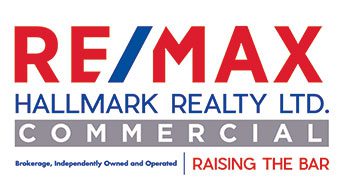
“Like the pandemic, it’s like a once-in-a-100-year situation that we’re dealing with.”
That was JLL Canada chief executive officer Alan MacKenzie’s reply when asked if there was any precedent for the strong performance of the industrial market in the Greater Toronto Area, while the office sector remains in a slump.
JLL recently released reports covering first-quarter performances in those two areas and MacKenzie and senior research manager Scott Figler offered RENX their insights and forecasts.
Industrial performance remains strong
While the GTA industrial vacancy rate inched up 10 basis points to 1.7 per cent in Q1 2021 from its Q4 2020 performance, it has remained below two per cent for 10 consecutive quarters.
It’s the tightest MacKenzie’s seen in his 32 years in the real estate business. He expects vacancies of zero to 0.5 per cent over the next two years because supply can’t keep pace with demand, which is split 25 per cent for e-commerce, 25 per cent for logistics and distribution, 15 per cent for retailers and 35 per cent for other uses.
Three-quarters of the approximately 10 million square feet of industrial space under construction in the GTA has been pre-leased:
– S&S Activewear took almost 280,000 square feet at a property at 6675 Langstaff Rd. in Vaughan that’s under construction.
– In Durham Region, where a wave of speculative new product was recently delivered, Lear signed a 185,000-square-foot deal at Carttera’s 1652 Tricont Ave. in Whitby.
– In nearby Oshawa, Aosom.ca and Canatom signed major deals at Panattoni’s 1121 and 1147 Thornton Rd. S. site.
Q1 sales volume hit almost $1.3 billion, more than double the same period in Q1 2020 and almost five times the volume of Q2. The largest purchase was Triovest’s $125-million acquisition of a logistics centre at 100-110 Iron St. in Etobicoke.
Amazon purchased the former Pickering Markets flea market property on 40 acres at 1400 Squires Beach Rd. in Pickering for $40 million.
Deliveries in the first quarter totalled 1.6 million square feet, primarily consisting of Panattoni’s 1121 and 1147 Thornton Rd. development and Beedie’s Legacy Business Centre strata development at 2340 and 2370 Meadowvale Blvd. in Mississauga.
Deliveries this year are expected to reach 10.5 million square feet. That will fall short of the 11.9 million square feet of new supply in 2020, but would be well above the 6.5 million square feet averaged between 2014 and 2019.
Industrial rents and land prices continue to rise
Rental rates climbed to $10.39 per square foot during the quarter, up 9.8 per cent year-over-year.
“Up until 2015, there was very little rental growth and rents are now pretty much double what they were five years ago,” said Figler.
“If you’re an investor or developer in the industrial space right now in the GTA, you kind of have no risk because the rents are rising faster than the costs,” said MacKenzie.
Uncertainty in the office and retail sectors has somewhat dampened investor interest in them, but industrial land has been a hot commodity and well-capitalized developers are investing, which is driving up prices.
Figler said industrial, commercial and investment land comprised almost one-quarter of total sales in 2020 and is up to 26 per cent this year.
Investors are also continuing to acquire land in nearby secondary markets including Guelph, Kitchener-Waterloo, Cambridge and Hamilton to build industrial space on spec. JLL recently opened a Kitchener-Waterloo office to service that demand.
Downtown Toronto office vacancy
The downtown Toronto office vacancy rate rose from 5.1 per cent in the fourth quarter of last year to 8.4 per cent in Q1 2021. The vacancy rate a year earlier was 1.9 per cent.
The vacancy rate was somewhat artificially inflated because the increase included the 1.52-million-square-foot first tower at CIBC Square, which was 99 per cent pre-leased — but not occupied — upon delivery during the quarter.
“Anywhere else in the world, if your vacancy rate is where Toronto’s is right now, that’s considered a healthy market and probably a landlord-favourable market,” said Figler, an American who has previously worked in the United States and South America.
“The sky’s not falling. It’s actually a good thing for the health of the market.”
Figler said it was very difficult for companies to expand in downtown Toronto until last year, unless they pre-leased space in a new building. Now there are more opportunities.
Office occupiers have largely been shut out of their spaces for more than a year due to provincial guidelines and/or safety concerns due to COVID-19, and many are trying to figure out what their future footprints should be.
Overall downtown office leasing increased from 487,000 square feet in Q4 2020 to two million square feet in Q1 2021. Lease renewals accounted for approximately two-thirds of all activity, highlighted by high-profile occupiers including Scotiabank, Citi Canada and Facebook.
MacKenzie said renewals normally account for one-third of leasing activity.
Other notable direct lease deals included: the Ontario Ministry of the Attorney General signing a renewal for 248,000 square feet at Dream Office REIT’s 720 Bay St.; French University of Ontario taking 62,000 square feet at Daniels Waterfront at 130 Queens Quay E.; and Ransom Music Group taking 23,000 square feet at TAS Design Build’s 860 Richmond St. W.
Downtown office subleases are increasing
Downtown Toronto sublease availability rose 10 basis points to 3.4 per cent from the previous quarter, as many companies have attempted to sublet space as a cost-saving measure.
“Much of that sublet space that has added to the overall vacancy in Toronto hasn’t been leased out or moved,” said MacKenzie. “What has leased is the higher-quality sublets with longer remaining terms, like five-plus years left on the sublet, to make it more interesting for the tenants that are taking the space.”
While there was a small amount of sublet space added in the last quarter, it was less than in the previous three quarters. Figler believes Q4 2020 may have been the bottoming out point.
“We’re still going to see more added vacancies, but it’s not going to come from subleases. It’s going to come from end-of-contract renewals where tenants are able to downsize a bit and not get penalized for it.”
During the most recent quarter:
– PC Financial sublet 27,470 square feet to engineering and construction company Kiewit Corporation at 25 York St.;
– the Canadian Broadcasting Corporation sublet 23,000 square feet to game developer Zynga in the Canadian Broadcasting Centre at 250 Front St. W.;
– and Virtu Financial sublet 19,670 square feet to Hybrid Financial at Cadillac Fairview’s TD Centre at 222 Bay St.
The Toronto Stock Exchange took its 45,000-square-foot sublease at EY Tower at 100 Adelaide St. W. off the market, as it now plans to reoccupy the space. Other companies have been doing the same thing, according to MacKenzie.
The major downtown office deliveries in the second quarter will be: 1.07 million square feet, all of it pre-leased, at The Well; and 1.11 million square feet, 68 per cent of it pre-leased, at Menkes’ 100-125 Queens Quay E., that could spill over into the third quarter.
MacKenzie expects a stable downtown office vacancy rate for the next six to 12 months, but thinks demand will pick up as the economy rebounds and immigration returns.
Health and wellness considerations
While sustainability and health and wellness concerns were already growing in importance for tenants, the pandemic has heightened this. AAA office buildings used to be the highest structures in the downtown core, but MacKenzie said smaller buildings are now achieving AAA status because of health and wellness standards.
MacKenzie said B- and C-class buildings on the periphery of downtown that aren’t sufficiently capitalized to make significant improvements in those areas may have difficulty backfilling empty space when tenants leave, and rents may need to be lowered.
MacKenzie said JLL represents a number of tenants that want to relocate to new buildings under development with features such as: touchless washrooms, doors and elevators; more efficient air exchange systems; increased natural light; windows that open; and access to outdoor space.
He cited Portland Commons, The Well and Waterfront Innovation Centre as examples.
Suburban GTA office markets
The GTA North East’s office vacancy rate rose 90 basis points to 11.8 per cent in Q1, the third straight quarterly increase.
The GTA West rate increased 200 basis points to 16.1 per cent. That was impacted in a major way by Bell Canada making 615,000 square feet available for sublease at the Bell Mobility Campus at 5025 and 5115 Creekbank Rd. in Mississauga.
“There’s not as much of an uptick in vacancies and there’s not as much change in rents,” Figler said of the suburban GTA office performance. “If we haven’t seen any huge movement in the metrics by this point, I think there’s a sense in the market that we’ve probably made it through the worst.”
Figler has seen a shift to more use of a hub-and-spoke model, where companies maintain a primary office downtown and smaller spaces in the suburbs, but not a major flight to outlying areas.
He gave a hypothetical example of a company that had 50,000 square feet of space downtown keeping 35,000 square feet there and moving 7,500 square feet to Mississauga and 7,500 square feet to Markham, where rents are cheaper and the locations may be more convenient for some employees.
However, that model doesn’t make as much sense for companies with young talent, such as the tech sector, where most employees live downtown and don’t want to work in the suburbs.
“There’s a serious risk of making a move to save a little bit of money on the balance sheet but losing your top talent while doing that and destroying your company,” MacKenzie said.
Source Real Estate News Exchange. Click here to read a full story

Midtown Toronto’s urban heart around Eglinton subway station grows noticeably denser each year as new towers rise into the mix. Another pair of towers are soon to break into the local skyline, as the Plaza Midtown development infills a Tower-in-the-Park style site just north of Soudan Avenue that is already home to a pair of mid-20th century apartment towers that front on Dunfield Avenue and Holly Street to the east and west respectively.
The project from developer Plaza has been underway since Spring, 2019. It will add a pair of BDP Quadrangle-designed 27 and 34-storey condominium towers to the site beside the existing 14-storey rental buildings. Forming of the three-level underground parking garage is wrapping up at the S-shaped site, with the latest photos showing the project’s first forming going on above-grade.
The complex’s 27-storey tower is now starting to rise to the south of the existing Holly Street rental building, where forming of the ground floor is in full swing, and the first work has started on the slab forms for the second floor above.
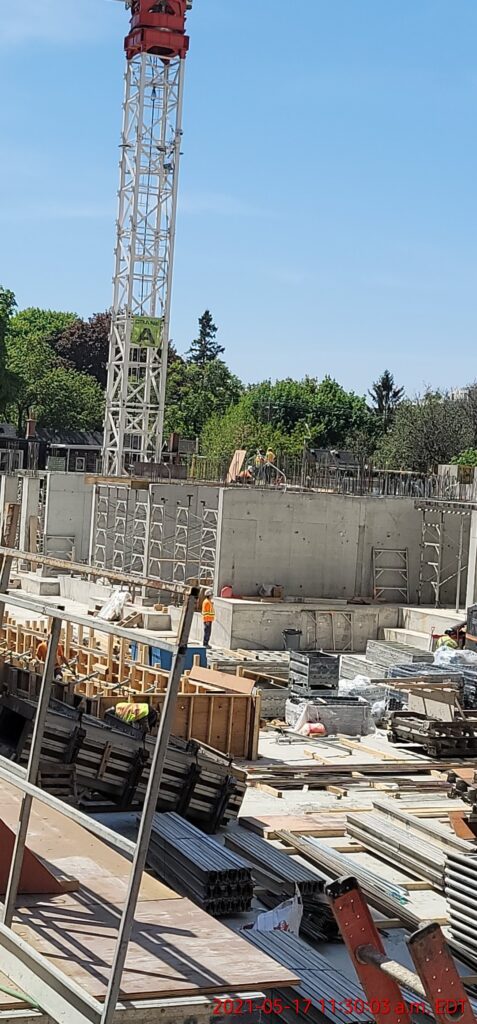
The 34-storey tower will soon make its presence felt north of the existing Dunfield building, with its ground floor now being formed in preparation for its climb into the skyline. Towards the interior of the site, forming continues of the garage’s P1 parking level, with work at the site soon to be entirely at or above grade.

Plaza Midtown will bring 545 new units to the block, to be joined in the future by a planned 1,550 m² City park fronting onto the northwest corner of Soudan and Dunfield.

Meanwhile, plans are in the works for another Plazacorp development in Midtown, with their recent partnering with Firm Capital, owners of a rental building on the southeast corner of Yonge Street and Woodlawn Avenue. The redevelopment of 1233 Yonge Street and 9 Woodlawn Avenue would replace the existing rental buildings with a new mixed-use development containing condo and rental units, and ground floor retail facing Yonge Street. Plaza is targeting the Fall for an application for Official Plan and Zoning by-law amendments to redevelop the site.

Source Urban Toronto. Click here to read a full story

IKEA is redeveloping ground and first floors of building into an IKEA store that would open around turn of the year.
STOCKHOLM — IKEA’s shopping malls business announced on March 18th it had bought the Shops at Aura mall in the centre of Toronto in Canada as part of the furniture group’s strategy shift towards inner cities.
It bought the mall, which has been struggling to attract tenants and visitors, from private equity firm KingSett Capital.
Ingka Centres, which has 46 malls anchored by IKEA stores across Europe, Russia and China, said in a statement it would redevelop the ground and first floors of the building into an IKEA store that would open around the turn of the year.
It will be the first inner-city IKEA store in Canada. The building’s remaining mall space will mark Ingka Centres’ entry into Canada.
Located at the base of the Aura skyscraper, the property currently has around 12,000 square metres (14,350 square yards) of leasable area across three floors.
“The new downtown format IKEA store will comprise a large proportion of the redeveloped mall,” an Ingka Centres spokesman said.
Ingka Centres is scouting for inner-city property as part of IKEA’s shift in recent years towards the centres of large cities, away from out-of-town, in response to the shift to online shopping and other changing shopping behaviours. So far, such locations are leased.
It has earlier made two such acquisitions that it is in the process of developing: the King’s Mall in London and the 6×6 mall in San Francisco.
Ingka Centres is part of Ingka Group which owns most IKEA stores worldwide. It did not disclose the purchase price for the Toronto property.
Source Financial Post. Click here to read a full story

National Homes’ increasing focus on taller residential buildings will continue with the acquisition of a Brampton site with partner Brixen Development.
The vacant 2.49-acre property at 245 Steeles Ave. W., a few blocks west of Hurontario Street, was acquired from Sundial Homes in an off-market deal for an undisclosed price. Approvals were already in place to build two 25-storey condominiums before the acquisition closed on May 14 and the two partners will move forward with that plan.
The two towers will share a six-storey podium as well as underground and surface parking. There will be approximately 800 one-bedroom, one-bedroom-plus-den, two-bedroom and two-bedroom-plus-den units ranging in approximate size from 500 to 750 square feet.
The project still has to go through the site-plan approval process. Sales should launch this fall and prices haven’t been revealed. National Homes president and managing partner Jason Pantalone told RENX he would like construction to start next summer, with first occupancy in the summer of 2025.
The two developers have assembled a consulting team comprised of architectural firm IBI Group, interior architectural design firm Esqape Design, sales and marketing company Baker Real Estate Incorporated and branding and marketing agency L.A. Inc. to assist them with the project.
Brampton development site
Brampton has less high-rise development than neighbouring cities Toronto and Mississauga, and Pantalone said National Homes previously held off launching such a project in the city because it couldn’t make the economics work.
Things have changed, however, with construction of the 18-kilometre, 19-stop Hurontario Light Rail Transit line going north from Port Credit to the Brampton Gateway terminal, where it meets the Züm Transitway, a five-minute walk from the development site.
“It’s really opened up the opportunities for Brampton high-rise development,” said Pantalone. “Prices have finally started to catch up on the revenue side in terms of end sale prices. So when the opportunity came to us, we ran our numbers and did our pro forma and we were really excited to see a great opportunity, given the transit orientation of the site.”
Shoppers World Brampton is about a five-minute walk east of the site, while Sheridan College’s Brampton campus is about the same distance to the west.
Partnership with Brixen
Brixen was formed in 2019 by Andrew Iacobelli, who was previously with Queensgate Homes, and Alex D’Orazio, who had previously worked for The Automated Group, Minto and CentreCourt. D’Orazio is also Pantalone’s cousin.
Woodbridge, Ont.-based Brixen has two other ongoing developments in its home province.
South District is a 183-unit condo at 681 Yonge St. in Barrie that’s slated for completion next spring. The Bronte is a 128-unit condo at 2430 Old Bronte Rd. in Oakville with a fall 2023 target completion date.
Pantalone said National Homes will oversee financing, sales and marketing for the Brampton development while Brixen will primarily be in charge of construction.
“It was a good fit, with their experience and our experience,” said Pantalone. “We’ve built over 10,000 units in the Brampton community and our name is really well-known there, so our brand will bring a lot of value to the project.”
National Homes’ evolution
The National Homes Group of Companies was founded by Rocco Pantalone and is based in Concord, just north of Toronto. It’s comprised of: Pantalone Realty Corporation, Venturon Development Corporation, Vertical Builders Inc. and National Homes, which started in 1992.
National Homes has built more than 15,000 homes, developed more than 20,000 acres of land and constructed thousands of square feet of retail and commercial space. Pantalone, his sister Deena and brother Matthew took over the business from their father seven years ago.
“National historically has been a low-rise and mid-rise builder, but since my brother and sister and I took over the company we’ve been focusing on high-rise and mid-rise buildings,” said Pantalone. “Policy changes, availability of land, and uncertainty and the risk of long-term land opportunities has changed over the years.
“I feel like our focus is now on transit-orientated urban development sites that offer amenities to the community.”
Half of National Homes’ entirely Ontario-based portfolio is comprised of low-rise homes, while higher density developments make up the other half.
“Single-family homes are a dying breed,” said Pantalone. “It’s very difficult to find single-family development sites where you can sell for under $1 million. You have to go pretty far outside the GTA to get to those types of developments and then the absorption starts to dwindle.
“We’re as far west as Burlington and as far east as Courtice and as far north as Bradford, where we’re finishing construction on a site now.”
National Homes wants future projects to stay within those boundaries. It has approximately 2,000 units in its short-term development pipeline and over 2,000 more in the longer-term pipeline.
Still to come from National Homes
The first phase of 210 units in townhomes and semi-detached houses in Tyandaga Heights on the Park on Brant Street in Burlington is sold out. Servicing of the site started recently, with a second phase scheduled to go on sale this fall.
Another Burlington development, at a current shopping plaza at 484-490 Plains Road East, will have two eight-storey condos and stacked townhouses with a total of approximately 400 units. National Homes is waiting for the retail leases at the plaza to expire before it launches sales in spring of 2022.
National Homes just launched sales of The Vale in Courtice, east of Oshawa. The site is just north of Lake Ontario and beside a forest at the intersection of Bloor Street and Prestonvale Road.
The development will have 110 townhomes priced from the $500,000s to the upper $700,000s.
A 105-townhouse development at 1240 Britannia Rd. W. in Mississauga is in the approvals stage. Pantalone hopes to launch sales this fall.
National Homes owns 200 acres in Milton with a partner that wishes to be unnamed. More than 2,000 units in medium- to higher-density buildings will be developed in five projects. Pantalone would like to launch initial sales in 2024.
Source Real Estate News Exchange. Click here to read a full story
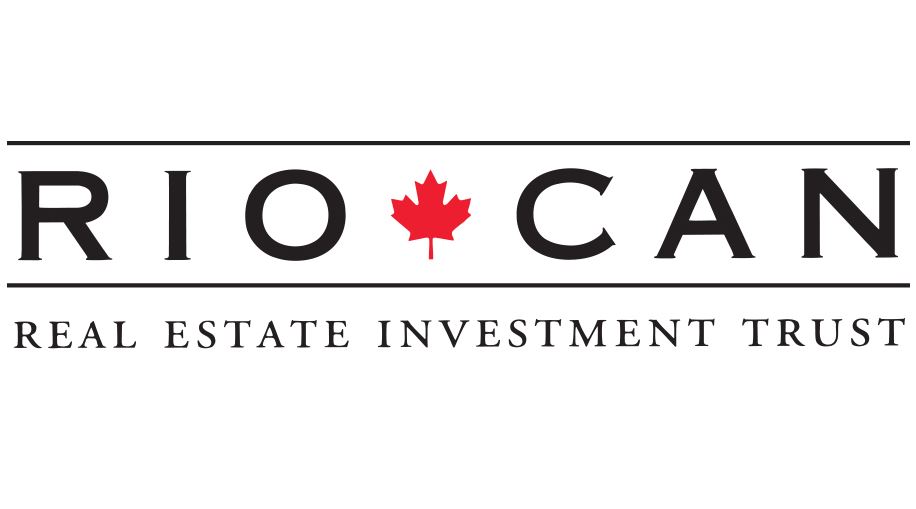
Jonathan Gitlin has hit the ground running during his first few weeks as the president and CEO of RioCan REIT. The trust recently announced a major new development and partnership, and on Tuesday released its Q1 2021 earnings report.
Gitlin added the CEO title to his previous role as president when trust founder Ed Sonshine retired from the role at the end of March. Sonshine remains RioCan’s non-executive chairman.
In its first major announcement under Gitlin, RioCan (REI-UN-T) unveiled its involvement in the new QA Condos mixed-use development on Queen Street East near Coxwell Avenue in Toronto. The project will be developed in a 50/50 partnership with Context and in collaboration with the City of Toronto and Toronto Community Housing (TCHC).
The 3.5-acre site at 1555 Queen St. E. will include:
– a new building to replace the TCHC’s existing 120 apartment units on the site, which will be retained and owned by TCHC;
– 367 new condominium units, 183 market rental units, 50 affordable rental units, and 32 affordable rental units that will be sold to the city upon completion at a pre-determined price;
– and approximately 16,000 square feet of new podium retail space.
Housing for all income levels
The Teeple Architects-designed condo component is already 88 per cent pre-sold. Units in the 17-storey building will range in size from 415 to 1,987 square feet and amenities will include: co-working space; a lobby lounge; a yoga studio; a mezzanine lounge; courtyard gardens; a steam room and sauna; a spin studio; a parcel room; a lobby with concierge; a rooftop party room; a fitness centre; and an outdoor dog run.
The site is currently owned by TCHC, but RioCan and Context are expected to gain title to their portion of the site once a severence is completed. The partners will then proceed with demolition activity. They’ve proceeded with the pre-construction phases of the project in the interim.
“The project will provide vital retail amenities and add much-needed housing for all income levels,” Gitlin said during the May 4 conference call to reveal the first-quarter results.
“In addition, it will contribute to Toronto’s community economic development initiatives, including a $100,000 scholarship fund for affordable rent tenants, a $250,000 economic and social development fund and a minimum of $500,000 in value for job opportunities.”
RioCan has forward purchase obligations to purchase Context’s 50 per cent interest in the retail and residential rental components of the project upon meeting certain pre-determined thresholds, such as reaching certain stabilized net operating income targets, certain time limits or certain planning act compliance requirements.
RioCan’s residential and mixed-use developments
QA Condos forms part of the current pipeline of 1,609 condo and townhouse units under construction or in pre-sale by RioCan and its partners.
All 153 townhome units in phase one of U.C. Towns, and all 503 condo units at U.C. Towers, part of the Windfields retail and residential development in Oshawa, have been sold. Both are in partnership with Tribute Communities.
Sales have reached 99 per cent of the 586 condo suites at 11YV in Toronto (in partnership with Metropia and Capital Developments).
The REIT also reported more than 98 per cent of residential rents were collected from 1,218 units during Q1 2021 at its occupied apartment buildings at eCentral and Pivot in Toronto, Frontier in Ottawa and Brio in Calgary.
RioCan sold a 50 per cent non-managing interest in its residential rental and retail eCentral/ePlace property and its Rhythm rental apartment development in Ottawa to WoodBourne Capital Management for $156.2 million in the first quarter.
More than 1,450 residential rental units are under construction between six projects. Gitlin expects RioCan will have an additional 1,014 units in different phases of development by 2023.
Development spending for this year is expected to be approximately $500 million. Residential development represents almost 82.8 per cent of RioCan’s 41.8-million-square-foot development pipeline.
“We’ll use our vast pipeline of air rights and we’ll seek out partners to enhance value, reduce our overall development exposure and, equally as important, get paid for our deep and experienced development and residential platforms through equitable fee structures,” Gitlin said during the earnings call.
Capital recycling program
RioCan is one of Canada’s largest REITs. It owns, manages and develops retail-focused and increasingly mixed-use properties.
Its portfolio at the end of 2020 was comprised of 223 properties with an aggregate net leasable area of approximately 38.3 million square feet, including office, residential, retail and 14 development properties.
RioCan’s capital recycling program has involved $543.1 million worth of closed, firm and conditional deals so far in 2021, including $421.2 million in income-producing retail and mixed-use properties. That money will be primarily used to pay down debt, but also to fund new developments.
“Seizing on a sizeable disconnect between private and public market valuations, we’re raising capital efficiently by selling assets,” said Gitlin. “Retail now serves as a very interesting value proposition for a lot of investors, be they syndicators, small pension funds, institutions or even high-net-worth individuals who really like the prospect of retail assets.
“We’re seeing a number of different types of buyers on a number of different types of assets.”
Gitlin said the list of assets RioCan is selling doesn’t come close to reflecting the demand from people wanting to buy assets from the REIT, and valuations are reverting to higher pre-pandemic levels.
“Once we reached our target of 90 per cent major market-focused, we turned the tap off a little bit on our aggressive disposition program in secondary markets,” said Gitlin, though RioCan could become a more aggressive vendor if it sees a benefit.
Other first-quarter RioCan highlights
Here are other highlights from RioCan’s first quarter:
– Net income increased to $106.7 million from $102.8 million in the pre-pandemic first quarter of 2020.
– It executed 1.1 million square feet of new and renewed commercial leases, with a new leasing spread of 14.2 per cent and a blended spread of 8.1 per cent.
– Committed commercial occupancy improved by 10 basis points from the fourth quarter of 2020 to 95.8 per cent.
– It collected 93.9 per cent of commercial rents despite some forced business closures and having restrictions placed on some of those that remained open due to COVID-19.
– It had $1.3 billion of liquidity in the form of cash and cash equivalents and undrawn lines of credit on a proportionate share basis.
– It had an unencumbered asset pool of $8.7 billion.
– Senior vice-president and chief financial officer Qi Tang took part in her final earnings call, as she’ll pursue other opportunities as of May 12. Finance vice-president Franca Smith will serve as interim CFO until Tang’s successor is found.
“Our focus right now is making sure our balance sheet is improved to the point where, when we can turn to more of an offensive posture, our balance sheet is in great shape to make that turn,” Gitlin concluded.
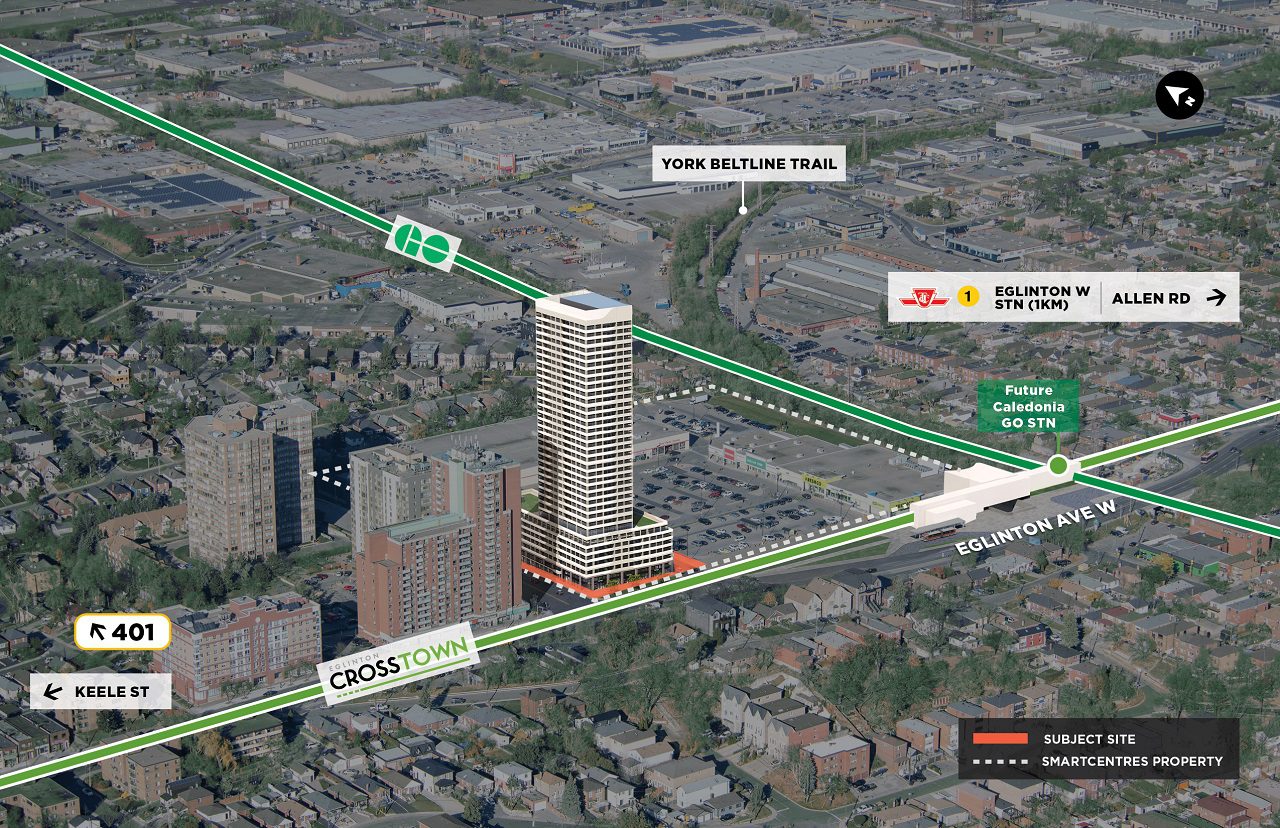
New rapid transit—both planned and under construction across Toronto—promises increased connectivity for many neighbourhoods, and creates opportunities for TOD—Transit Oriented Development—in the process. The future Crosstown LRT has created several TOD opportunities along the less-densely built-out Eglinton East, though development along the Crosstown’s Eglinton Avenue West stretch has been limited to more constrained sites, with few TOD opportunities west of Yonge. 2400 Eglinton Avenue West is one such site to have its development potential enhanced by future improved connectivity. Developer SmartCentres REIT recently applied for rezoning to bring a new 35-storey tower to the site, part of a wider planned community known as SmartCentres Eglinton West.
Located immediately adjacent to Caledonia station on the Crosstown LRT, the site is situated to take full advantage of multi-modal transit infrastructure. By the time residents move in, the new Metrolinx Caledonia station will be served by TTC buses and the GO Train servicing the Barrie GO Line with direct access to Union from Caledonia. A short ride to the west along the Crosstown will also allow residents to transfer to the Union Pearson Express, direct access to the Airport. The opening of the Crosstown will also improve travel times while making streets more pleasant for pedestrians too.
When in operation, the Crosstown LRT trains will make the trip between Keele and Eglinton West stations in just six minutes. By boarding at Caledonia station, residents of SmartCentres Eglinton West will be able to make it to the TTC’s Line 1 University subway in five minutes, and the Yonge subway in just five more.
Set to rise to 110.8 metres from a seven-storey, L-shaped podium, the planned Turner Fleischer Architects-designed project is being developed by SmartLiving, SmartCentres’ residential sub-brand. The 29,683 m² building will be predominantly residential in use with 400 units in a range of layouts, to be supported by 2,460 m² of amenity space, while the ground floor along Eglinton will be animated by 715 m² of new street-fronting retail space.

Design-wise, the podium features deviations from the traditional condominium tower massing that has been incorporated in response to the surrounding conditions. The east podium facade features a prominent curve, mirroring the former path of the Beltline here, while another curve to the south hugs the alignment of Eglinton Avenue West. Other more subtle gestures include decorative curved detailing on the tower facades and mechanical penthouse levels, with this horizontal banding to be executed using perforated metal finishes.
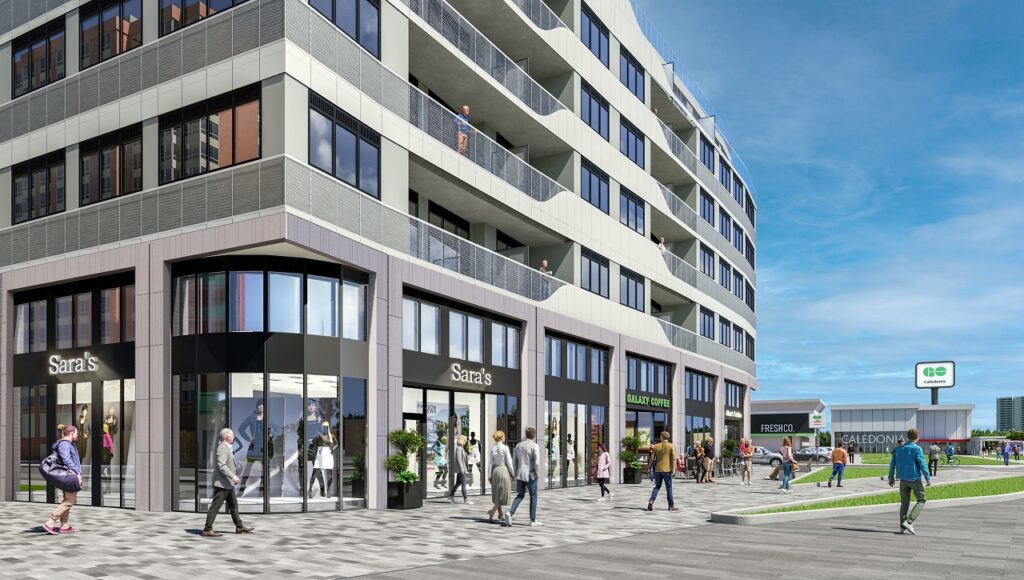
With 360 long-term and 40 short-term bicycle parking spaces in the building, residents will be able to take good advantage of the nearby Beltline Trail—approximately 250 metres from the site—offering cyclists and pedestrians a multi-use path extending to the Don Valley.
Amenity spaces will include a party room, gym, guest suite, and a landscaped rooftop deck, and suites will cater to a wide demographic. Ranging in size from 600 to over 1,000 ft², in one, two, and three-bedroom layouts, of the total 400 units, 160 are planned to be multi-bedroom suites. With suite sizes, pricing, and amenity offerings being competitive with Downtown condominiums, and with abundant transit options providing quick commutes around the city and to the surrounding region, the project is expected to attract residents ranging from university students to young professionals to new families looking for livability at a more affordable price point.
The proposal marks the first phase of a planned Transit Oriented Community with adjacent access to both LRT and GO Transit stops. One of the first major developments on Eglinton West in a generation, the project also has the potential to shape future transit-oriented developments in sites unlocked by new transit expansion.
Source Urban Toronto. Click here to read a full story



















